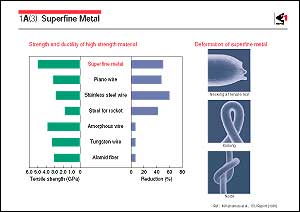The highest strength steel material
now in practical use is named Superfine Metal in the form of
ultra-fine wire having about ten times the strength of general-purpose
ordinary carbon steel (SS400), as shown in the figure.
This improved material contains 0.15% carbon, 0.8% silicon, and
1.5% manganese, and is vacuum-melted to reduce the content of
such impurities as phosphorus, sulfur, oxygen, and nitrogen.
It is then hot rolled to produce wire rod and heat-treated to
form a structure in which martensitic-phase particles are dispersed
in a ferrite matrix. Wire rod with this structure is reduced
to ultra fine wire by cold-drawing through a die, the cross-sectional
area being reduced by 99.99%, from 3mm to 30μm in diameter. Such
heavy reduction is possible because the hard martensitic phase
is made fine and surrounded by the soft ferritic phase. Ferrite
work-hardens as a result of heavy processing and, at the same
time, becomes a fibrous structure elongated in the working direction.
The intervals between fibers are extremely narrow at 50 nanometers.
This refinement effect endows the material with characteristically
high ductility despite its super-high strength. The good formability
of this material can be clearly seen in the photograph. |
|
 |
 |
 |
|
|